Birds are a common sight in the Parkway, with a wide variety of species in the area. From the majestic Bald Eagle to tiny warblers, birds of all shapes and sizes can be seen along the Parkway.
The Parkway is home to various habitats, including mountain meadows, riparian areas, and forests, which provide birds with a wealth of resources.
Birdwatchers, photographers, and nature enthusiasts can enjoy the many opportunities to observe birds on the Parkway.
Whether you are a novice or an experienced birder, the Parkway offers something for everyone.
24 Birds to Watch in Parkway
This verdant expanse is 24 avian wonders, each possessing unique plumage, captivating calls, and fascinating behaviors that make them a joy to behold.
From the majestic soaring of raptors to the delicate melodies of songbirds, Parkway offers a haven for bird enthusiasts and nature lovers alike.
Here are 24 Birds to Watch in Parkway.
1. Northern Flicker
The Northern Flicker, or Common Flicker, is a bird that belongs to the woodpecker family. It is native to many areas in North America, Central America, Cuba, and the Cayman Islands.
The woodpecker species is unique because it is one of the few species in its family that are migrating.
This means that when the seasons change, the Northern Flicker will travel to other regions to survive the cold or lack of food in its native habitat. The Northern Flicker is a medium-sized bird, about 12-15 inches long.
Its feathers are mostly brown and black, with occasional white and red markings. It has a long, pointed bill and a long, barred tail with a white rump.
The Northern Flicker also has a distinctive call that can be heard in many areas. The Northern Flicker feeds on ants, beetles, and other insects it finds by foraging in the ground. It also eats fruits, nuts, and seeds.
It builds its nest in a tree or stump cavity, usually about 10-40 feet off the ground.
The Northern Flicker is an integral part of the ecosystem, helping to keep insect populations in check. The Northern Flicker is a fascinating bird that can survive and thrive in many habitats.
Its ability to migrate makes it an essential part of the environment, helping to maintain balance among different species.
| Kingdom | Animalia |
| Phylum | Chordata |
| Class | Aves |
| Order | Piciformes |
| Family | Picidae |
| Genus | Colaptes |
| Species | C. auratus |
2. Red-Winged Blackbird
The red-winged blackbird is a passerine bird species belonging to the family Icteridae. It is found throughout North America and Central America, from Alaska in the north to Panama in the south.
These birds are typically about 12 to 14 inches long and are easily identified by their black bodies, bright red and yellow wings, and shoulders.
They are often found in open grasslands, wetlands, and marshes. Red-winged blackbirds typically feed on insects, such as grasshoppers, and sometimes small vertebrates, such as frogs. They also consume some plant matter, such as seeds and berries.
They often forage in flocks and can be seen perched on wire fences, tree branches, or other elevated perches. The red-winged blackbird is an essential species in many North American ecosystems.
They are an essential food source for many predators, including hawks, owls, and foxes. They also help to disperse seeds, which helps to maintain the health of many habitats.
| Kingdom | Animalia |
| Phylum | Chordata |
| Class | Aves |
| Order | Passeriformes |
| Family | Icteridae |
| Genus | Agelaius |
| Species | A. phoeniceus |
3. Belted Kingfisher
The belted Kingfisher is a large bird that is native to North America and is a member of the water kingfisher family. The water kingfisher family, also known as Alcedinidae, was considered to be composed of all kingfishers.
However, recent research has indicated that the Alcedinidae family should be divided into three distinct subfamilies.
The three subfamilies include the Alcedininae, which consists of the belted Kingfisher; the Halcyoninae, which consists of the tropical kingfishers; and the Cerylinae, which consists of the river kingfishers.
Each of the three subfamilies includes a unique species of kingfishers with distinct features that make them different from others.
The belted Kingfisher is a giant bird compared to the tropical Kingfisher and usually has a bluish-gray back, white head, and rufous band on its breast.
This bird is typically found near bodies of water, such as lakes, rivers, and streams, where it hunts for small fish and aquatic insects. Its presence is easily detected by its loud, rattling call.
The tropical kingfishers are smaller than the belted kingfishers and are usually brightly colored, with various patterns and color combinations.
These birds are typically found in tropical and subtropical regions, hunting insects, small fish, and other small animals. The river kingfishers are medium-sized birds and are usually brownish-gray in color with a reddish-brown band across their breast.
These birds are usually found near rivers and streams, hunting for small fish, aquatic insects, and other small animals. Recent research has suggested that the Alcedinidae family should be divided into three distinct subfamilies.
Each subfamily has its unique characteristics and is composed of different species of kingfishers. As a result, it is essential to be aware of the differences between each subfamily to identify various species of kingfishers correctly.
| Kingdom | Animalia |
| Phylum | Chordata |
| Class | Aves |
| Order | Coraciiformes |
| Family | Alcedinidae |
| Genus | Megaceryle |
| Species | M. alcyon |
4. Great Blue Heron
The great blue heron is a majestic creature that can often be seen near the coastlines of North and Central America, as well as in parts of South America, the Caribbean, and the Galápagos Islands.
It belongs to the heron family Ardeidae and is a large wading bird with a wingspan of up to six and a half feet.
They can typically be spotted near open water and wetlands, where they can use their long, thin legs and necks to search for food, such as fish, amphibians, and small reptiles. Great blue herons have beautiful plumage, with gray, white, and blue feathers that give them a striking appearance.
They are often seen standing in shallow water, looking for prey before they launch into the air with a graceful flap of their wings.
When they are in flight, they can be seen soaring above the wetlands, with their long necks tucked close to their bodies and their long legs trailing behind.
The great blue heron is an essential part of the ecosystem in which it lives, both as a predator and as food for other species.
It is a fantastic sight to behold, and its presence is a testament to the beauty and diversity of our planet’s wildlife.
| Kingdom | Animalia |
| Phylum | Chordata |
| Class | Aves |
| Order | Pelecaniformes |
| Family | Ardeidae |
| Genus | Ardea |
| Species | A. herodias |
5. Common Yellowthroat
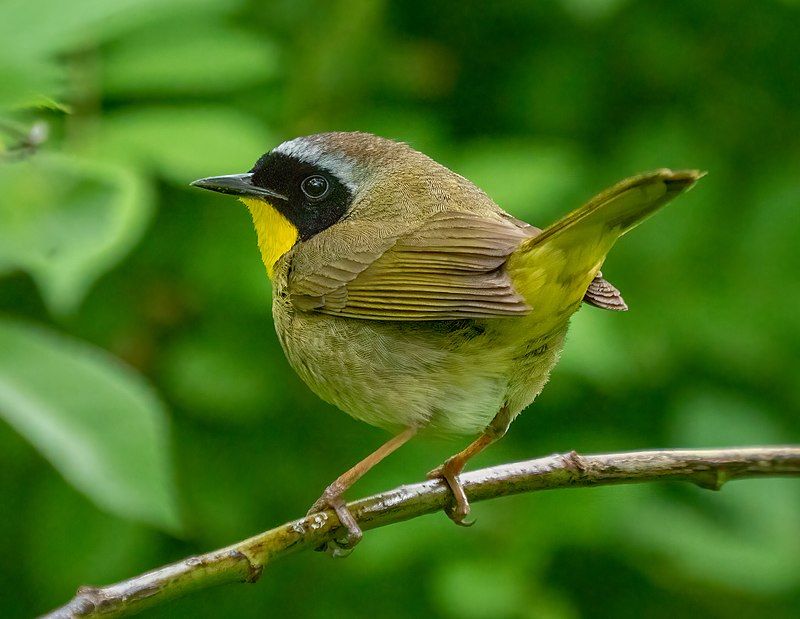
The common yellowthroat is a New World warbler native to North America. It is also known as “yellow bandit” and “Maryland yellow-throat.”
It is a very abundant species in this region, stretching from southern Canada to central Mexico. The common yellowthroat is a small bird, usually measuring around 5 inches long.
Its most defining feature is its bright yellow throat and upper breast, which stand out against its olive-green back and wings. It also has a white eye ring and a black mask around its face.
The male and female are pretty similar in appearance, although the female is slightly duller in color. The common yellowthroat is an insectivore, and its diet consists mainly of small insects, such as mosquitoes, beetles, and caterpillars.
It is often seen foraging in shrubs and low vegetation and can also be found along the edges of ponds and streams. During the breeding season, they form monogamous pairs and build cup-shaped nests on or near the ground.
The female usually lays 2-6, e.g.,ge incubated for about two weeks before hatching. The common yellowthroat is a very successful species with a stable population.
| Kingdom | Animalia |
| Phylum | Chordata |
| Class | Aves |
| Order | Passeriformes |
| Family | Parulidae |
| Genus | Geothlypis |
| Species | G. trichas |
6. Red-Tailed Haw
The red-tailed hawk is an impressive bird of prey widespread across much of North America. It is found in various habitats, from the remote wilderness of Alaska and northern Canada to the warmer climes of Panama and the West Indies.
This species is a member of the genus Buteo, a group of birds common worldwide, especially in North America. The red-tailed hawk is a medium-sized raptor, typically with a wingspan of up to 1.5 meters and a body length of around 50 cm.
It has various colorings but is most easily identified by its distinctive reddish-brown tail feathers.
The male and female look similar, although the female is typically more significant than the male. The red-tailed hawk is a mighty hunter, capable of taking down a wide variety of prey. This includes small mammals, birds, reptiles, amphibians, and fish.
They typically hunt from a high perch, scanning for potential prey below. Once something is spotted, they swoop down and snatch up their victim. The red-tailed hawk is also a capable scavenger often seen at carrion or garbage.
They often scavenge in large groups and can even be seen stealing food from other birds or animals. The red-tailed hawk is an integral part of North American ecosystems, keeping populations of small animals in check.
They are an essential part of the food chain, and their presence helps keep the local environment healthy. They are also beautiful birds to observe in the wild, and their distinctive call is often heard echoing through the trees.
| Kingdom | Animalia |
| Phylum | Chordata |
| Class | Aves |
| Order | Accipitriformes |
| Family | Accipitridae |
| Genus | Buteo |
| Species | B. jamaicensis |
7. Black-Crowned Night Heron

The black-crowned night heron is a species of heron that can be found throughout much of the world. It is typically called the night heron in Eurasia, though it is sometimes called the black-capped night heron.
This medium-sized heron is found in various habitats, including parts of Europe, Asia, and North and South America.
It typically inhabits areas near bodies of water, such as marshes, swamps, and rivers, where it can hunt for its favorite prey, small fish and crustaceans. The black-crowned night heron has a distinct appearance, with its black-tipped wings and black crown.
Its body is typically grayish-brown in color, and it has a long, yellow beak. The bird generally is about two feet long and weighs around two to three pounds.
It is an active bird, often flying low to the ground for food. The black-crowned night heron is a social bird, frequently found in groups of up to a dozen or more. During the breeding season, nests are made in trees or reeds near the water.
Both parents care for the young, and young birds often remain with their parents for some time after birth. The black-crowned night heron is a widespread species with a stable global population.
It is not currently classified as threatened or endangered, though it is subject to some threats from human activity, such as habitat loss and hunting.
| Kingdom | Animalia |
| Phylum | Chordata |
| Class | Aves |
| Order | Pelecaniformes |
| Family | Ardeidae |
| Genus | Nycticorax |
| Species | N. nycticorax |
8. Ash-throated Flycatcher
The ash-throated flycatcher is a species of passerine bird that belongs to the tyrant flycatcher family. This family of birds is commonly found in North and South America, with some species migrating into Mexico and even Central America.
The ash-throated flycatcher is a medium-sized bird with greyish-brown upper parts and a lighter, yellowish-brown belly. Its most distinctive feature is the greyish-white throat patch that distinguishes it from other tyrant flycatchers.
It also has a long, thin bill and a white eyebrow stripe. This species is usually found in open woodlands, riparian areas, and desert scrub, where they hunt for insects in the air and on the ground. They are also known to feed on fruits and berries.
The ash-throated flycatcher is a solitary bird usually seen alone or in pairs. During the breeding season, they often form small colonies near water or in dense vegetation. The female lays up to five eggs in a nest made of grass and twigs.
Both the male and female share in the incubation and care of the young birds.
| Kingdom | Animalia |
| Phylum | Chordata |
| Class | Aves |
| Order | Passeriformes |
| Family | Tyrannidae |
| Genus | Myiarchus |
| Species | M. cinerascens |
9. White-Breasted Nuthatch
The white-breasted nuthatch is a species of bird that is part of the nuthatch family, Sittidae. This bird species is known for its unique size, as it is a medium-sized nuthatch measuring approximately 15.5 cm in length.
This relatively small bird makes it difficult to spot among its larger counterparts. It is found in North America, inhabiting deciduous and coniferous forests. The white-breasted nuthatch is a plump bird with a grey-blue upper body and a white underside.
Its long, sharp beak is used to feed on insects and other invertebrates. It is also known for its habit of clinging to the sides of trees and using its beak to search for food.
The white-breasted nuthatch is a social bird, forming small flocks and communicating with each other with various calls. They are also known for their ability to fly upside down and sideways, an adaptation that helps them find food and navigate their environment.
| Kingdom | Animalia |
| Phylum | Chordata |
| Class | Aves |
| Order | Passeriformes |
| Family | Sittidae |
| Genus | Sitta |
| Species | S. carolinensis |
10. Spotted Towhee
The spotted towhee is a large sparrow found in the New World. The classification of the towhees has been a source of debate in recent years, and until 1995, the spotted towhee and the eastern towhee were thought of as one species, known as the rufous-sided towhee.
This species was also referred to as the Oregon towhee. However, this is now outdated. The spotted towhee is a distinct species, different from the eastern towhee, and is part of the New World sparrow family.
It is known for its distinctive black-and-white spotted pattern in various regions across the United States and Canada.
It is a relatively large species, more significant than most other sparrows, and has many habitats, including forests, woodlands, shrublands, and grasslands.
The spotted towhee is an important species to the birding community and is a conservation concern due to its declining population in some areas.
| Kingdom | Animalia |
| Phylum | Chordata |
| Class | Aves |
| Order | Passeriformes |
| Family | Passerellidae |
| Genus | Pipilo |
| Species | P. maculatus |
11. American Robin
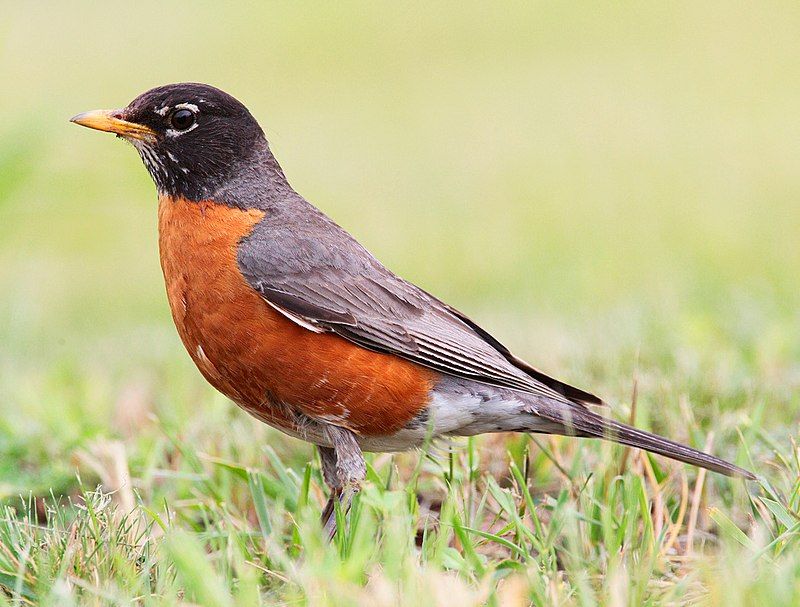
The American robin is a species of bird that belongs to the valid thrush genus and Turdidae, a large family of thrush species. Its name was derived from the European robin, which is not related to the American robin, despite their similar appearances.
The American robin is known for its reddish-orange breast, which resembles the European robin’s, and it is a migratory species, meaning that it travels from place to place in search of food and better living conditions.
On the other hand, the European robin belongs to the Old World flycatcher family and is not a migratory species.
| Kingdom | Animalia |
| Phylum | Chordata |
| Class | Aves |
| Order | Passeriformes |
| Family | Turdidae |
| Genus | Turdus |
| Species | T. migratorius |
12. Ring-Billed Gull
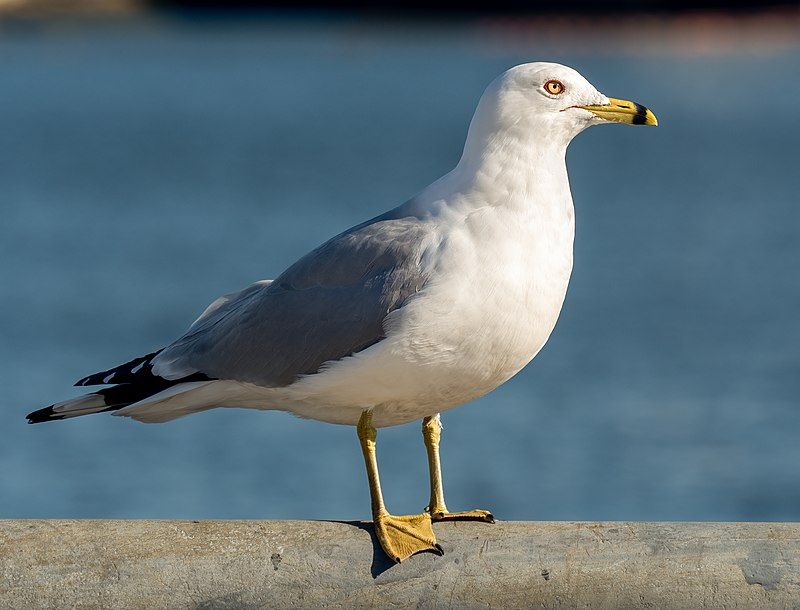
The ring-billed gull is a species of seabird belonging to the genus Larus, derived from the Latin term for gull or other large seabird.
This species is considered medium size, and its name, delawarensis, is attributed to the Delaware River, where it is commonly found.
The presence of the ring-billed gull in the Delaware River is thought to have been brought about by the construction of the Chesapeake and Delaware Canal in the early 19th century, as this provided the gulls with a more convenient route for migratory flight.
As a result, the species has become an abundant region resident. Aside from its presence in the Delaware River, the ring-billed gull can also be found in other areas along the Atlantic coast and the Great Lakes region.
These gulls are often seen in large flocks near shorelines and beaches, and they have adapted to human presence, readily scavenging for food in urban areas. In addition to being found in the United States, the ring-billed gull is also a native species in Canada and Mexico.
| Kingdom | Animalia |
| Phylum | Chordata |
| Class | Aves |
| Order | Charadriiformes |
| Family | Laridae |
| Genus | Larus |
| Species | L. delawarensis |
13. Pied-Billed Grebe
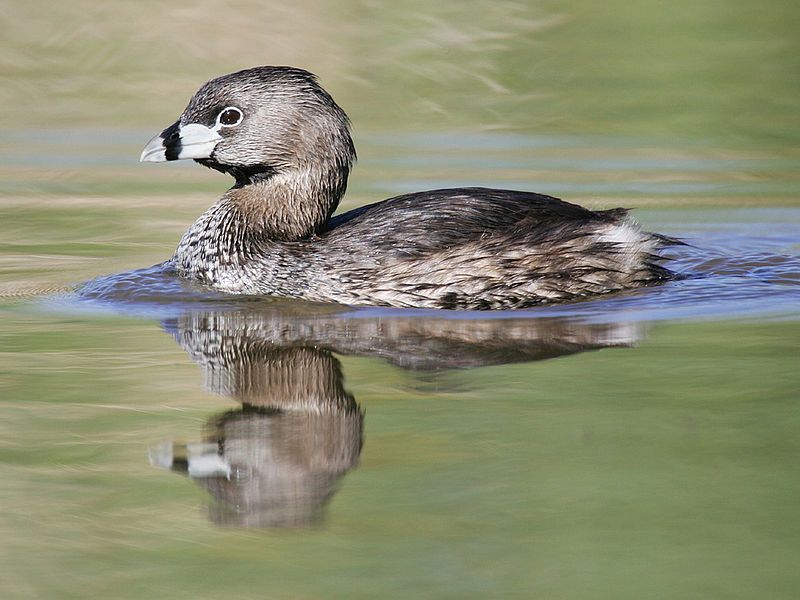
The pied-billed grebe is a small water bird belonging to the Grebe family. It is the only living species of its genus, Podilymbus, as the Atitlán grebe is now extinct. This grebe species is found in freshwater ponds throughout the Americas, from Canada to Argentina.
It is a relatively small bird, with a total length of about 25-35 cm and a wingspan of approximately 45 cm. The pied-billed grebe has a distinctive black-and-white plumage and a bright yellow bill with a black band near the tip.
It feeds on aquatic invertebrates and small fish, frogs, and even aquatic plants. It is a highly adaptable species that can survive in many habitats, including stagnant or slow-moving water.
Breeding season usually begins in late winter and continues until summer. During this period, the pied-billed grebe builds a floating nest out of vegetation and lays two to six eggs.
This grebe species is not considered endangered, but its population is declining due to habitat destruction and water pollution. Conservation efforts are needed to ensure its survival.
| Kingdom | Animalia |
| Phylum | Chordata |
| Class | Aves |
| Order | Podicipediformes |
| Family | Podicipedidae |
| Genus | Podilymbus |
| Species | P. podiceps |
14. Marsh Wren
The marsh wren is a small bird that belongs to the Wren family. It is native to North America and is known for its melodic songs. Its scientific name is Cistothorus palustris.
To differentiate it from the sedge wren, it is also known as the long-billed marsh wren because its bill is longer than the sedge wren. On the other hand, the sedge wren is known as the short-billed marsh wren because its bill is shorter than the marsh wren.
The marsh wren is a small bird with a slender body and a short tail. It has a greyish-brown back, a white belly, and a black and white striped breast. It also has a long bill that is typically curved downwards. Its habitat includes marshy areas, cattail marshes, and wet meadows.
It builds its nest in grasses and reeds along the edges of water bodies like ponds, lakes, and marshes. The marsh wren has a wide array of vocalizations, which it uses to communicate with members of its species.
Its song consists of a rapid series of loud and short notes that can be heard from afar. It also has a variety of calls, including a sharp kip and a chattering noise. The marsh wren feeds on insects, spiders, and other small invertebrates.
It forages for food on the ground or in the air. It also eats some seeds and berries. The marsh wren is an essential species in North American ecosystems. It helps regulate populations of insect pests, and its song is an integral part of the soundscape of many wetlands.
| Kingdom | Animalia |
| Phylum | Chordata |
| Class | Aves |
| Order | Passeriformes |
| Family | Troglodytidae |
| Genus | Cistothorus |
| Species | C. palustris |
15. American Coot
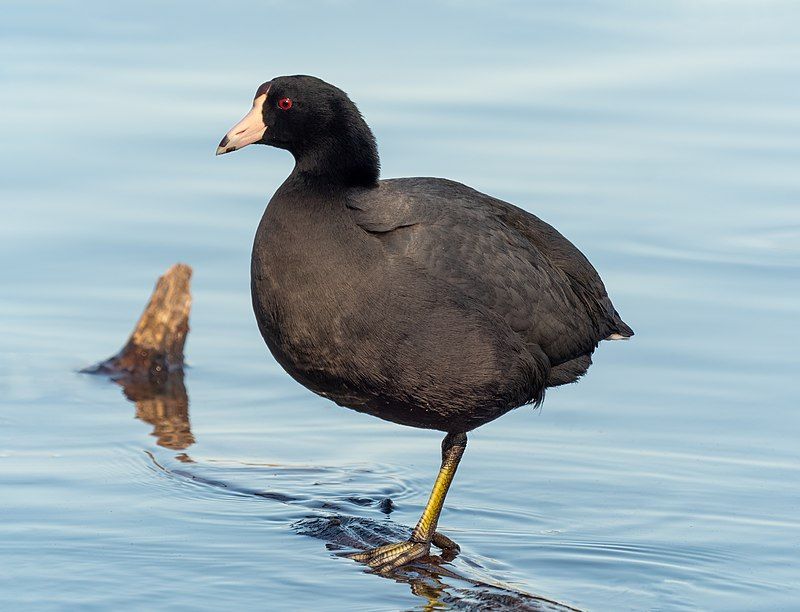
The American coot is a unique bird that should not be confused with a duck. It is a member of the Rallidae family and is also called a mud hen or rouleau. Despite the similar appearance, it is only distantly related to ducks and belongs to a separate order.
This bird has a unique body shape: a short neck, a plump body, and an oversized head. Its wings are short and rounded, helping it move quickly through and across the water.
The Americacoastot can be found throughout North America, although its population is declining due to habitat destruction. It is a shy and solitary bird, usually found in shallow wetlands and marshes.
It feeds mainly on aquatic vegetation but also eats small invertebrates and insects. The American coot is an integral part of the local environment and helps to keep wetlands healthy.
| Kingdom | Animalia |
| Phylum | Chordata |
| Class | Aves |
| Order | Gruiformes |
| Family | Rallidae |
| Genus | Fulica |
| Species | F. Americana |
16. Black Phoebe
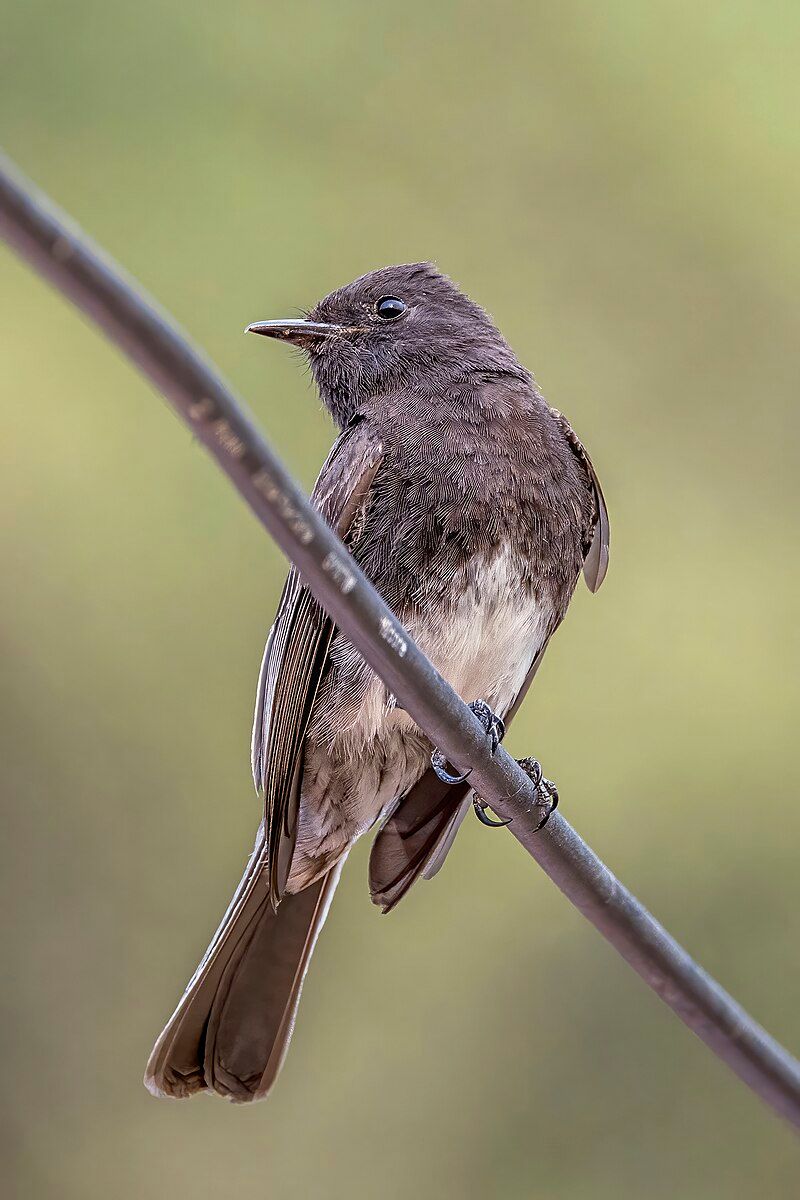
The black phoebe is a species of songbird belonging to the family of tyrant flycatchers. It is native to the western regions of the United States, including Oregon and California, and is also found in Central and South America.
Unlike many other birds in its genus, the black phoebe does not migrate for most of its range, although the northern populations may migrate seasonally.
This species is present year-round in most of its range, providing an essential food source for other birds and small mammals. Its diet consists mainly of insects, which it catches on the wing, small berries, and seeds.
The black phoebe is an integral part of the avian ecosystem, helping to control insect populations and providing food for other species.
| Kingdom | Animalia |
| Phylum | Chordata |
| Class | Aves |
| Order | Passeriformes |
| Family | Tyrannidae |
| Genus | Sayornis |
| Species | S. nigricans |
17. Downy woodpecker
The Downy Woodpecker is a type of woodpecker found in North America. It is the smallest of the woodpecker species, and its length ranges from 14 to 18 centimeters.
This species can be found in many different forested areas across the United States and Canada but is absent from the deserts of the southwest and the tundra in the northern regions.
Downy woodpeckers are primarily found in forested areas, where they can find plenty of food sources and shelter.
They feed on various insects, fruits, nuts, and seeds, which they find in the bark and crevices of trees. They are also known to store food under the bark of trees.
This species is distinguished by its black and white barred wings, white breast, and the red patch on the back of its head.
The Downy Woodpecker is an essential species in the ecosystem, as it helps to control insect populations, disperses seeds, and is an important food source for predators such as hawks and owls.
This species is also a famous backyard bird, and its distinctive call can often be heard in the early morning.
| Kingdom | Animalia |
| Phylum | Chordata |
| Class | Aves |
| Order | Piciformes |
| Family | Picidae |
| Genus | Dryobates |
| Species | D. pubescent |
18. Oak Titmouse
The oak titmouse is a small bird that belongs to the Paridae family.
This bird species was initially considered one single species, known as the plain titmouse. Still, in 1996, the American Ornithologists’ Union separated it into two distinct species: the oak titmouse and the juniper titmouse.
This decision was based on multiple factors, including their songs, preferred habitats, and genetic makeup. The oak titmouse is found in the western United States and Mexico.
It prefers open woodlands, wooded canyons, and oak groves, where it can easily find food sources from insects, spiders, and other invertebrates.
Its song is a high-pitched “tseet” sound, similar to a squeaky toy. On the other hand, the juniper titmouse is found on the opposite side of the North American continent, in the eastern United States and Canada.
It prefers wooded areas with juniper trees, where it can feed on insects, spiders, and berries. Its song is a low-pitched, mellow “tseet” sound, like a clarinet. Genetically, the oak titmouse and the juniper titmouse also differ.
Studies have found that the two species have different mitochondrial DNA sequences, confirming their separation. The oak and juniper titmouse are distinct species with unique songs, preferred habitats, and genetic makeup.
This separation was formally recognized in 1996 by the American Ornithologists’ Union.
| Kingdom | Animalia |
| Phylum | Chordata |
| Class | Aves |
| Order | Passeriformes |
| Family | Paridae |
| Genus | Baeolophus |
| Species | B. inornatus |
19. White-Crowned Sparrow

The white-crowned sparrow is a species of passerine bird native to North America. It is classified as a medium-sized bird belonging to the New World sparrow family.
This species is easily identifiable by its grey face and distinctive black and white streaking on the upper head. The black and white streaking pattern can vary from bird to bird, with some having more of a striped pattern than others.
The white-crowned sparrow is adaptable in various habitats, from open grasslands to urban areas. It is also a very social bird, often seen in flocks foraging for food.
These birds are commonly seen in western and northern parts of North America during the warmer months and can also be seen in parts of Mexico during the winter.
The white-crowned sparrow is an integral part of the local ecosystem, providing food for many species of animals and helping to spread the seeds of native plants.
| Kingdom | Animalia |
| Phylum | Chordata |
| Class | Aves |
| Order | Passeriformes |
| Family | Passerellidae |
| Genus | Zonotrichia |
| Species | Z. leucophrys |
20. Yellow-Breasted Chat
The yellow-breasted chat is a large songbird that is native to North America. It is the sole member of the Icteriidae family, although it was previously classified as a New World Warbler family member.
In 2017, the American Ornithological Society (AOS) moved the yellow-breasted chat to its own family, although its taxonomic classification is still unresolved.
This reassignment of the bird’s family is based on several physical characteristics, such as size, plumage, and behavior. The yellow-breasted chat has a large, rounded body, long tail, bright yellow throat, and breast.
It is known for its loud, song, which it often uses to attract mates. It is also a very active bird, frequently seen flitting around for food. While the AOS has placed the yellow-breasted chat in its own family, not all scientists agree on this decision.
Therefore, the bird’s taxonomic classification is still a matter of debate.
| Kingdom | Animalia |
| Phylum | Chordata |
| Class | Aves |
| Order | Passeriformes |
| Family | Icteriidae |
| Genus | Icteria |
| Species | I. virens |
21. Cliff Swallow
The cliff swallow (also known as the American cliff swallow) is a type of bird from the family Hirundinidae. This family comprises swallows and martins, two birds that share many similarities.
The cliff swallow is a passerine bird, which means it is a perching bird with strong feet adapted for perching. Its small, streamlined body and pointed wings help it fly quickly and with agility. Its diet consists mainly of insects, which it catches while in flight.
It is found in various habitats, including open fields, grasslands, and rocky cliffs. The cliff swallow builds its nest in sheltered areas, such as on the underside of bridges and other structures.
It is a social bird, often seen in flocks of up to several hundred individuals. The cliff swallow is an integral part of the avian ecosystem, helping to keep insect populations in check.
| Kingdom | Animalia |
| Phylum | Chordata |
| Class | Aves |
| Order | Passeriformes |
| Family | Hirundinidae |
| Genus | Petrochelidon |
| Species | P. pyrrhonota |
22. White-Throated Sparrow
The white-throated sparrow is a species of bird found in the New World.
It is part of the family Passerellidae, commonly known as the “New World Sparrows.” It is a passerine bird, meaning it is part of the order Passeriformes, which includes most of the world’s songbirds.
This bird species is known for its distinctive white throat patch, usually bordered by black streaks. It is found in many habitats, from open woodlands and meadows to urban areas. It feeds mainly on seeds and insects.
The white-throated sparrow is considered a songbird, and its song is a series of short, simple trills. It is an important species for many birders, as it is one of the first species to arrive in spring and the last to leave in fall.
| Kingdom | Animalia |
| Phylum | Chordata |
| Class | Aves |
| Order | Passeriformes |
| Family | Passerellidae |
| Genus | Zonotrichia |
| Species | Z. albicollis |
23. Canada Goose
The Canada goose is a large wild goose native to North America. It has a black head and neck, white cheeks, a white under its chin, and a brown body.
This goose is found in both the arctic and temperate regions of North America and occasionally migrates across the Atlantic Ocean to northern Europe. These birds are easily recognizable due to their distinct features and can often be seen flying in large flocks.
They are well-known for their loud honking sound and are a common sight in many parks and open areas. Canada geese are an essential part of the ecosystem, as they provide food for other animals, such as foxes and coyotes, and help spread seeds and fertilize the soil.
They are also crucial in the cultural identity of many North American countries, as they are seen as a symbol of freedom and resilience.
| Kingdom | Animalia |
| Phylum | Chordata |
| Class | Aves |
| Order | Anseriformes |
| Family | Anatidae |
| Genus | Branta |
| Species | B. canadensis |
24. Gadwall

The gadwall is a bird species belonging to the duck family known as Anatidae. It is a dabbling duck, meaning it feeds by tipping its body forward and submerging its head underwater to find food at the bottom.
This species is found in most parts of the world, from Europe and North America to Australia and New Zealand. It is a widespread duck found in various habitats such as lakes, ponds, marshes, and wetlands.
The gadwall is easily recognizable by its gray-brown body and white underbelly. It has a distinctive black tail and a white line down the side of its head. It is also known for its loud and continuous call.
The gadwall is an essential species in wetlands, as it plays a crucial role in regulating the balance of the aquatic ecosystem by controlling populations of marine invertebrates.
| Kingdom | Animalia |
| Phylum | Chordata |
| Class | Aves |
| Order | Anseriformes |
| Family | Anatidae |
| Genus | Mareca |
| Species | M. strepera |
Conclusion
Birds are an essential part of the Parkway ecosystem. They provide crucial services such as pollination, pest control, and seed dispersal. They are also a source of beauty and entertainment for visitors.
Therefore, it is essential to protect birds and their habitats in the Parkway and ensure they can continue to thrive in this unique environment.